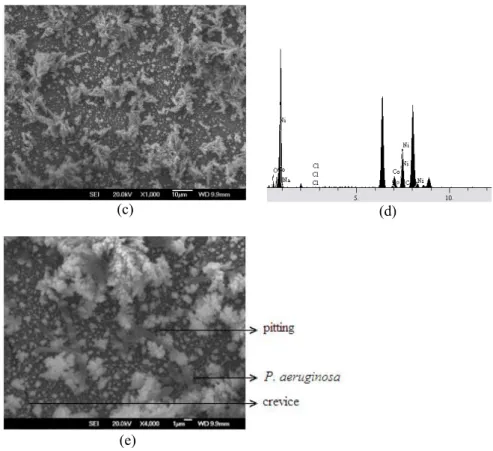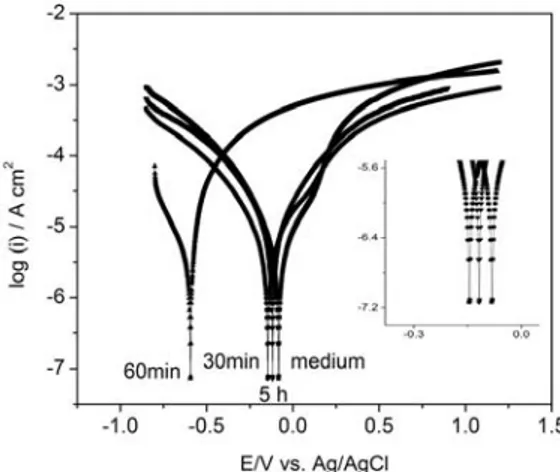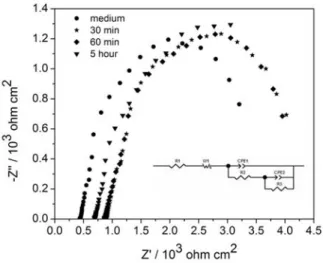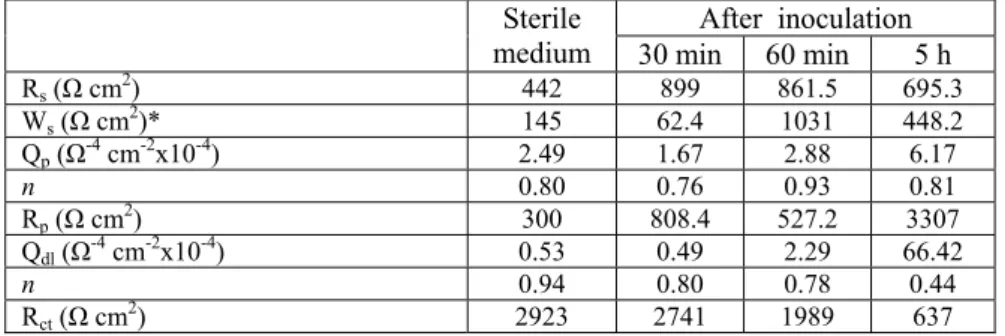THE INFLUENCE OF Pseudomonas aeruginosa ON CORROSION BEHAVIOR OF NICKEL-COBALT ALLOY
NALAN OYA SAN1 AND HASAN NAZIR2*
1Ankara University, Institute of Biotechnology, 06100 Beşevler-Ankara, Turkey 2*Faculty of Science, Department of Chemistry 06100 Beşevler-Ankara, Turkey
(Received April 18, 2010; Accepted June 26, 2010)
ABSTRACT
The aim of this study was to determine the effect of Pseudomonas aeruginosa bacterium on the corrosion of nickel-cobalt (Ni-Co) alloy. The corrosion rate was determined with using of Tafel slopes and Electrochemical Impedance Spectroscopy (EIS). The morphology and the formation of the alloy surface were observed by scanning electron microscopy (SEM) and energy dispersive X-ray spectra (EDS) analysis. It was observed from the Tafel plots that the polarization resistance decreases and the current density increases with a change in time. This was attributed accumulation to the biofilm on the surface and therefore surface became pitted. The Nyquist semicircles tended to open at lower frequencies which indicated the crevice of the surface and the rupture of protective film.
KEYWORDS: Microbial Corrosion; Nickel-Cobalt Alloy; SEM; EIS
INTRODUCTION
Nickel electroplating is utilized in large number of applications due to its advantages such as strength, toughness and resistance to corrosion/wear 1-2. Ni–Co alloy, which possess good adhesion, low-stress, corrosion resistance, and be thermally stable with excellent magnetic properties 3. Physicochemical interactions between a metallic material and its environment can lead to corrosion. Electrochemical corrosion is a chemical reaction involving the transfer of electrons from zero valent metal to an external electron acceptor, causing release of the metal ions into the surrounding medium and deterioration of the metal. This process proceeds through a series of oxidation (anodic) and reduction (cathodic) reactions of chemical species in direct contact with, or in close proximity to, the metallic surface 4-6. Metal surfaces are rapidly colonized by microorganisms in contact with natural or industrial aquatic environments, giving rise to a complex and strongly adhering microbial community, termed as ‘‘biofilm” 7. The biofilm accumulation not only protects microbial cells from the external environment, but it is also detrimental to the underlying
substratum, thereby causing physical degradation or biodeterioration of the metal surface 8-9. This phenomenon is widely recognized as biocorrosion or microbiologically influenced corrosion (MIC) 10-11. Electrochemical methods, including direct current methods, alternating current impedance spectroscopy, and electrochemical noise measurement, are commonly used to study MIC. These methods, however, often assume uniform chemical and electrochemical conditions 12-13. In reality, the biofilm tends to create non-uniform surface conditions, leading to localized corrosion.
In the present study, Pseudomonas aeruginosa influence on the corrosion of Ni-Co alloy in nutrient medium has been examined with using electrochemical techniques. In addition, scanning electron microscopy (SEM) was used to examine the surface after the corrosion measurements. P. aeruginosa was chosen due to its widespread behaviour in nature 14-15. The microorganism used in this study is an aerobic, heterotroph, motile, Gram-negative bacterium, producing large amount of exopolysaccharide, called biofilm.
MATERIALS AND METHODS
Microorganism and culture conditions
This study was performed with pure culture of P. aeruginosa obtained from Ankara University, Biotechnology Laboratory in Ankara, Turkey. The bacterium was cultured for 24 hours in a 100 mL Erlenmeyer flask containing 20 mL of the Nutrient Broth medium (peptone from meat 5.0 g, meat extract 3.0 g in 1 L.) on a rotary shaker (New Brunswick Scientific Innova 4230) with 100 rpm, 30±1 °C. The cultured bacterium (20 mL) was centrifuged at 5000×g for; 10 min (Hettich EBA12) then pellet was used for biocorrosion experiments.
Scanning Electron Microscopy
The surface morphology of the Ni-Co deposited brass discs were examined by scanning electron microscopy and elemental analysis was taken out with energy dispersive X-ray spectra (JEOL JSM-7000F Field Emission SEM-EDAX).
Electrochemical measurements
The EIS and polarization curves were measured with using Compactstat potentiostat (IviumStat, The Netherlands). The EIS measurements were carried out at 5 mV (root mean square) applied voltage at sinusoidal wave in the frequency range 20 kHz - 50 mHz. The EIS measurements were conducted of OCP 5 h. The polarization curve scanning rate was 1 mV/s, with a scanning range from -0.20 V of OCP to +0.20 V of OCP. Steel disc was used as a working electrode (A= 0.204 cm2). The Ag/AgCl (sat. KCl) electrode was used as the reference in which all potentials refer. The counter
electrode was a platinum wire. Ni-Co alloy, used as a working electrode, was electrodeposited from a nickel-cobalt bath. The Ni-Co bath solution contained 1 M NiSO4.7H2O, 0.2M NiCl2.6H2O, 0.6 M H3BO3, 0.05 M CoSO4 (5:1:2.5:5) v/v). The electrodeposition was performed chronoamperometric and -1.2 V was applied to the electrolysis system for 150 s during the Ni-Co coatings.
RESULTS AND DISCUSSIONS
SEM study
“Fig. (1a)” and “Fig. (1b)” show the SEM images of the Ni-Co discs surfaces immersed in the medium without P. aeruginosa and with P. aeruginosa after incubation for 5 h. In “Fig. (1a)” the oxide components of Ni and Co can be clearly seen. As displayed in “Fig. (1b-1e)” after 5 hours of immersion with medium containing bacterium, it can be seen that the Ni-Co surface partially covered with clusters of microbial cells, extracellular polymeric substance (EPS) and metabolism products. In addition, from the “Fig. (1e)”, pitting corrosion and crevice corrosion were observed on the surface of the inoculated medium rather than on the surface exposed to only medium. The EDS analysis of the corrosion products on discs was illustrated in “Fig. (1d)”.
At the end of the EDS analysis, the oxide percentage of the alloy surface exposed with bacterium was 11.80% (“Fig. (1d)”) where as the alloy surface exposed to the medium was 9 point lower oxide percentage. We conclude that P. aeruginosa enhanced corrosion rate due to aerobic respiration.
(c) (d)
(e)
Fig. 1. The SEM micrograph of the surface of the Ni-Co coated discs exposed to (a) medium and (b, c, e) medium with P. aeruginosa, (d) The EDS spectrum of the Ni-Co coated disc after incubation for 5 h in the medium with P. aeruginosa.
Polarization curves
The polarization curves from the Ni-Co electrodes immersed in the medium and inoculated medium after incubation periods of 30, 60 minutes and 5 hours were shown in “Fig. (2)”. Value of the electrochemical corrosion parameters was shown in Table 1. It can be seen that after being incubation in medium for 5 h, the corrosion potentials of Ni-Co electrodes were -0.082 V. However, the corrosion potentials of Ni-Co electrodes in the inoculated medium with bacterium for 30 min were shifted to -0.144 V. When time increased (60 min) corrosion potential was shifted to cathodic site (-0.594 V) and at the end of 5 h due to biofilm formation, corrosion potentials were shifted to anodic site again as, -0.117 V. Due to microbial activity Ecorr values began to shift cathodic site first then shifted to anodic site because of the biofilm formation. In addition increase of corrosion current and corrosion current
densities with an increase in incubation time, which meant the increased rate of corrosion and the pitted surface. Furthermore, when biofilm began to comprise on the disc surface, polarization began to decrease, as well, which encouraged the increasing corrosion rate.
Fig. 2. Polarization curves of Ni-Co alloys in medium for 5h and medium with bacterium for 30, 60 min and 5h.
Table 1. The corrosion parameters determined from the polarization curves for Ni-Co alloys in the medium and P. aeruginosa inoculated medium for 5h.
Sterile medium After inoculation 30 min 60 min 5 h Ecorr V vs Ag/AgCl -0.082 -0.145 -0.594 -0.117 icorr μA 2.555 3.345 1.607 4.793 Icorr μA/cm2 13.04 17.07 8.199 24.45 Anodic tafel slope βa V/dec 0.238 0.347 0.074 0.311 Cathodic tafel slope βc V/dec 0.268 0.331 0.218 0.310
Rp Ω 9305 9554 6482 6108
Electrochemical Impedance Spectroscopy
It was shown in “Fig. (3)” the EIS and equivalent circuit used in the analysis of Ni-Co alloy in the medium and inoculated medium. The impedance graphs obtained for the Ni-Co alloys exposed to various experimental conditions were fitted double-layer equivalent circuit. Based on the equivalent circuits, the EIS data were fitted well. In the circuit, Rs is the resistance of solution, Ws is the resistance of the transport process which it is described by the Warburg impedance Ws, Rp is the resistance of inhibitor film pore and Rct is the resistance of charge transfer. Qp and
Qdl, CPE parameters for inhibitor film and double layer. “n” is depicted as the dispersion parameter and its value being less than the one indicating an imperfect capacitor. Increase of the roughness or the lateral and vertical heterogeneity of the surface film means the decrease of the conductivity and n value. The fitting parameters of the EIS for Ni-Co alloys in the medium and P.aeruginosa inoculated medium are given in Table 2. The inspection of Rp related to the resistance of the biofilm formed upon the surface shows that it increases from 527.2 Ω in the 60 min inoculated medium to 3307 Ω after the inoculation for 5 hours. The increase in the Rp values after a certain time may be attributed to the increased porosity of the lateral and vertical heterogeneity of the surface 16. The increase in R
ct causes the increase in the potential of the capacitive component parallel to it. This eventually leads to an increase in the corrosion rate. Similarly, the decrease in the Rct has the same effect that enables the easy diffusion of electro active species through the biofilm formed on the surface such as seems to control suggests that the increase in Rct value for 5 h of immersion is due to build up the corrosion of coated surface 17-18.
Fig. 3. The EIS and equivalent circuit Ni-Co alloy in the medium and medium with bacterium.
Table 2. Electrochemical model impedance parameters of the Ni-Co alloy in the medium and P. aeruginosa inoculated medium.
Sterile medium 30 min After inoculation 60 min 5 h
Rs (Ω cm2) 442 899 861.5 695.3 Ws (Ω cm2)* 145 62.4 1031 448.2 Qp (Ω-4 cm-2x10-4) 2.49 1.67 2.88 6.17 n 0.80 0.76 0.93 0.81 Rp (Ω cm2) 300 808.4 527.2 3307 Qdl (Ω-4 cm-2x10-4) 0.53 0.49 2.29 66.42 n 0.94 0.80 0.78 0.44 Rct (Ω cm2) 2923 2741 1989 637 CONCLUSIONS
In summary, this study provided an initial look at the role of the microbially influenced corrosion of Ni-Co alloy by P. aeruginosa. We determined the effect of the MIC using electrochemical techniques and surface analyses. In order to clarify the effect of the bacterium, we immersed Ni-Co alloys in medium and inoculated medium. The corrosion potential of the Ni-Co alloy reached the minimum value when the electrode had been exposed for 5 h in the medium; however, after 60 min of immersion in the medium, the corrosion potential increased gradually, reaching the breakaway potential and leading more easily to corrosion. However, at the end of 5 h, the corrosion potential for the inoculated medium began to decrease and closed the medium’s corrosion potential. SEM analysis showed that P. aeruginosa attached and formed a biofilm layer on the Ni-Co alloy’s surface, even though cobalt is toxic to a variety of microorganisms 19-20.
ACKNOWLEDGEMENTS
Financial support was provided by the Scientific and Technological Research Council of Turkey (TÜBİTAK-BİDEB).
ÖZET: Bu çalışmanın amacı, Pseudomonas aeruginosa bakterisinin nikel-kobalt (Ni-Co) alaşımına korozyon etkisinin incelenmesidir. Korozyon oranı, Tafel ve elektrokimyasal empedans spektroskopisi (EIS) ile belirlenmiştir. Alaşım yüzeyinin morfolojisi ve bileşimi taramalı elektron mikroskobu (SEM) ve X-ışınları saçılımı (EDS) ile incelenmiştir. Tafel grafikleri, zamana bağlı olarak polarizasyon direncinin düştüğünü, akım yoğunluğunun ise arttığını göstermiştir. Bu değişim yüzeyde oluşan biyofilm tabakası ve çukurcuk korozyonu nedeniyledir. Nyquist yarım darireleri düşük frekanslarda açık hale gelmektedir. Korozyonun artığını gösteren bu değişim, alaşım yüzeyinde meydana gelen yarılma ve biyofilm tabakasında oluşan çatlaklardan dolayıdır.
REFERENCES
[1] Srivastava, M., Selvi, E., Grips, V.K.W., Rajam, K.S., 2006. Corrosion resistance and microstructure of electrodeposited nickel–cobalt alloy coatings, Surf. Coat. Technol., 201: 3051–3060.
[2] Chang, L.M., An, M.Z., Shi, S.Y., 2005. Corrosion behavior of electrodeposited Ni-Co alloy coatings under the presence of NaCl deposit at 800 ºC, Mater. Chem. Phys., 94: 125-130.
[3] Shi, L., Sun, C.F,. Zhou, F., Liu, W.M., 2002. Electrodeposited nickel–cobalt composite coating containing nano-sized Si3N4, Mater. Sci. Eng. A., 397: 190–194.
[4] Melidis, P., Sanozidou, M., Mandusa, A., Ouzounis, K., 2007. Corrosion control by using indirect methods, Desalin., 213: 152–158.
[5] Ornek, D., Wood, T. K,. Hsu, C.H., Mansfeld, F.,2002. Corrosion control using regene-rative biofilms (CCURB) on brass in different media, Corros. Sci., 44: 2291–2302 . [6] Alvarez, R.B.,Martin, H.J., Horstemeyer, M.F., Chandler, M.Q., Williams, N., Wang,
P.T., Ruiz, A., 2010. Corrosion relationships as a function of time and surface roughness on a structural AE44 magnesium alloy, Corros. Sci., 52: 1635–1648.
[7] H.C. Fleming, E. Heitz, H.C. Fleming, K. Sand, Microbially Influenced Corrosion of Materials, Spring-Verlag, New York, 1996, p. 5. 6–14.
[8] Duan, J.,Wu, S.,Zhang, X.,Huang, G.,Du, M., Hou, B., 2008. Corrosion of carbon steel influenced by anaerobic biofilm in natural seawater, Electrochim. Acta., 54: 22–28. [9] Messano, L.V.R., Sathler , L., Reznik, L.Y., Coutinho, R., 2009. The effect of biofouling
on localized corrosion of the stainless steels N08904 and UNS S32760,Int.Biodeter Biodegr., 63: 607–614.
[10] Melchers, R.E., 2002. Effect of temperature on the marine immersion corrosion of carbon steels, Corros. Sci., 58: 768–782.
[11] Pope, D.H., Morris, E.A., 1995. Some experiences with microbiologically influenced corrosion of pipelines, Mater. Perform., 34: 23–28.
[12] Heakal, F.E.T., Hefny, M.M., Tawab, A.M.A.E., 2010. Electrochemical behavior of 304L stainless steel in high saline and sulphate solutions containing alga Dunaliella Salina and β-carotene, J. Alloys. Compd., 491: 636–642.
[13] Starosvetsky, J., Starosvetsky, D., Pokroy, B., Hilel, T., Armon, R., 2008.
Electrochemical behaviour of stainless steels in media containing iron-oxidizing bacteria (IOB) by corrosion process modeling, Corros. Sci., 50: 540–547.
[14] S.J. Yuan , S.O. Pehkonen., 2007. Microbiologically influenced corrosion of 304 stainless steel by aerobic Pseudomonas NCIMB 2021 bacteria: AFM and XPS study, Corros. Sci., 50: 540–547.
[15] Abdelouas, A.,Lu, Y., Lutze, W., Nuttal, H.E.,1998. Reduction of U(VI) to U(IV) by indigenous bacteria in contamined ground water, J. Contam. Hydrol., 35: 217–233. [16] C.H. Hsu, F. Mansfeld., 2002. Corrosion control using regenerative biofilms (CCURB)
on brass in different media, Corros.Sci., 44: 2291–2302.
[17] K.Y. Chan, L.C. Xu, H.H.P. Fang, Anaerobic electrochemical corrosion of mild steel in the presence of extracellular polymeric substances produced by a culture enriched in sulfate-reducing bacteria, Enviren. Sci. Technol. 36 (2002) 1720-1727.
[18] Cetin, D, Aksu, M.L., 2009. Corrosion behavior of low-alloy steel in the presence of Desulfotomaculum sp., Corros. Sci., 51:1584-1588.
[19] Hassen, A., Saidi, N., Cherif, M., Boudabous, A., 1998. Effects of heavy metals on Pseudomonas aeruginosa and Bacillus thuringiensis, Bioresour.Technol.,65: 73–82. [20] Falih, A. M., 1997. Comparative toxicity of heavy metals to some yeast isolated from



